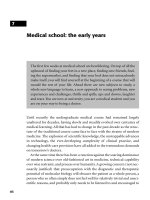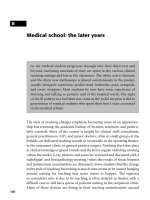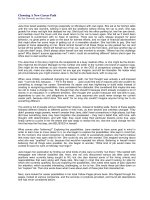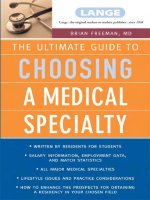Choosing a medical school
Bạn đang xem bản rút gọn của tài liệu. Xem và tải ngay bản đầy đủ của tài liệu tại đây (516.47 KB, 17 trang )
4
Choosing a medical school
49
The attitude that “beggars can’t be choosers” is not only pessimistic but
wrong. If, after serious consideration, you have decided that medicine
is the right career for you and you are the right person for medicine,
then the next step is to find a place at which to study where you can be
happy and successful. This chapter is designed to help guide you into
choosing the right schools to consider flirting with, rather than neces-
sarily ending up (metaphorically speaking, of course) in bed with.
Walk into any medical school in the country and ask a bunch of the students
which is the best medical school in the country and you will receive an almost
universal shout of “This one, of course!” The general public’s typical image of
medical students is one of a group of young people who live life to the full,
work hard, and play harder; hotheaded youngsters who can be excused their
puerile pranks and mischievous misdemeanours, because, “Well, they must
have a release from all that pressure, mustn’t they”. While this image should be
treated with the same caution that is required with any stereotype, it nonethe-
less contains grains of truth. When you further consider the outstanding abili-
ties of many medical students in their chosen extracurricular interests, it will
come as no surprise to find that medical schools are full of students letting their
hair down, getting involved in the things they enjoy, having a good time, and
still doing enough work to pass those dreaded examinations and assessments,
or at least most of the time anyway. The only dilemma you have is to find which
of these centres of social excitement and intellectual challenge best suits your
particular interests and nature. Like all the best decisions in life the only way to
find out is to do a bit of groundwork and research, plan out the lay of the land,
then follow your instincts and go for it.
Medical schools vary greatly in the size of their yearly intake (Table 4.1).
It is difficult to offer more precise advice about discovering the “spirit” or
“identity” of an institution. However hard it may be to define, all the medical
schools possess a uniqueness of which they are rightly proud. Of course some
schools wear their hearts more on their sleeves than others or have a more
easily identifiable image, but often the traditional identities are past memo-
ries, especially in London, where medical schools’ identities have changed
considerably in the past decade, particularly with recent amalgamations
between medical schools and their mergers with larger multidisciplinary
university colleges.
In days gone by a choice had to be made between a hospital-based medical
school, such as several in London, or an initially firmly multifaculty univer-
sity environment, with a much broader student community with greater
diversity of personalities, outlooks, and opportunities. This distinction has
largely now disappeared; only the course at St George’s in London is hospital
and medical school based throughout.
Accommodation may play an important part in choice, as some colleges
house all the medics in one hall of residence while others spread them out,
50 Learning medicine
so you may end up living on a corridor with a lawyer, a historian, a musician,
a dentist, a physicist, and someone who seems to sleep all day and smoke
funny smelling tobacco who is allegedly doing “Media Studies and Ancient
51 Choosing a medical school
Table 4.1. Predicted size of entry to first year of standard
course in medicine in UK medical schools for 2007
Over 350 Birmingham
King’s (University of London)
Manchester
Newcastle
Over 300 Cambridge
Imperial (University of London)
Leeds
Liverpool
Queen Mary’s (University of London)
UCL (University of London)
Over 200 Bristol
Edinburgh
Glasgow
Nottingham
Sheffield
St George’s, University of London
UWCM, Cardiff
150–200 Aberdeen
Dundee
Leicester
Oxford
Peninsula
Southampton
Queen’s, Belfast
Warw ick
Less than 150 Brighton-Sussex
East Anglia
Hull-York
Keele
St Andrew’s
Swansea
Icelandic”. Many find this kind of variety gives them exactly what they came
to university for and would find spending all their work and play time with
people on the same course socially stifling. While it is essentially a matter of
personal preference, it is also worth noting that both have pros and cons; for
example, when the workload is heavy it may be easier to knuckle down if
everyone around you is doing likewise. Conversely, when a bunch of medics
get together they inevitably talk medicine, and, although recounting tales
and anecdotes can amuse many a dinner party it may well breed narrow
individuals with a social circle limited only to other medics. Choosing a
campus site or a city site where you live side by side with the community
your hospital serves may also have a different appeal.
Increasing diversity is being introduced to the design of the curriculum and
how it is delivered. The traditional method of spending 2 or 3 years studying
the basic sciences in the isolation of the medical school and never seeing a
patient until you embarked on the clinical part of the course has all but disap-
peared. The teaching of subjects is generally much more integrated both
between the different departments and between clinical and preclinical
aspects. Even so, some curricula are predominantly “systems based” and others
“clinical problem based”. Much more emphasis is being placed in all courses on
clinical relevance, self-directed learning, and problem-solving rather than
memorising facts given in didactic lectures. There is substantial variation in the
extent to which these changes have evolved and in many respects there is
greater choice between courses than ever before. Diversity of approach is a
strength of the UK system: “You pay your money and take your choice”.
The courses at Oxford, Cambridge, and St Andrews remain more tradi-
tional in structure if not in subject matter and teaching methods. These
courses maintain a distinct separation between the more scientific and
the more clinical, although they have moved away to some extent from sep-
arate subjects towards systems-based teaching of the sciences and have
introduced reference to clinical relevance; their philosophy is that it is still
valid to study in depth the sciences related to medicine (anatomy, physiol-
ogy, biochemistry, pharmacology, and pathology) as disciplines important
in their own right, primarily as tools of intellectual development and scien-
tific education rather than of vocational equipment. Cambridge and
Oxford, however, have also introduced a 4-year course for graduate
students, which combines the intellectual rigour of the traditional course
with community-based clinical insights from the outset.
52 Learning medicine
At Oxford all the basic sciences required for the professional qualifica-
tions are covered in the intensive first five terms’work and are then exam-
ined in the first BM. All students then take in their remaining four terms the
honours school in physiology, a course much wider than its name suggests
with options to choose from all the basic medical sciences, including pathol-
ogy and psychology.
Cambridge adopts a more flexible approach. All the essential components
of the medical sciences course are covered in 2 years. The third year is spent
either studying in depth one of a number of medically related subjects, or
reading for a part II in any subject – law, music, or whatever takes their
fancy – provided they have a suitable educational background and their
local education authority is sufficiently inspired to support them. The 3 years
lead to an honours BA.
At St Andrews the students spend 3 years studying for an ordinary degree
or 4 years for an honours degree in medical sciences. Although strongly
science based, clinical relevance is emphasised and some clinical insights are
given, mainly in a community setting. Most St Andrews graduates go on to
clinical studies at Manchester University, but a few go to other universities.
By the year 2009 it is hoped that Scottish funding will enable St Andrews
graduates to stay in Scotland – in Glasgow, Edinburgh, Aberdeen, and
Dundee – for their clinical studies. The four ‘newest’ UK undergraduate
medical schools include Peninsula Medical School (Universities of Exeter
and Plymouth), University of East Anglia Medical School, Hull-York
Medical School and Brighton and Sussex Medical School – these opened
their doors to medical students in 2002 and 2003.
This then brings us back to those important but less tangible attractions
of each medical school, the spirit and identity of the place. Unless you are an
aficionado of architecture and simply could not concentrate unless in a neo-
classical style lecture theatre or an art deco dissecting room, then what gives
a place its unique character are the people who inhabit it; the biomedical
science teachers, the hospital consultants who involve themselves in student
life, the mad old dear who runs the canteen, the porter who knows every-
one’s name and most people’s business, the all important dean and admis-
sions tutor, and not least by any means the students themselves. It is the
ever-changing student body that above all else shapes the identity of a school
and certainly gives it spirit and expresses its ever-changing nature in a
dynamic spirit. Just listen to any final-year student bemoaning how the old
53 Choosing a medical school
place has changed and how the new first year just are not the same as the rest
of us and how what used to be like a rugby academy is more like a ballet school
these days. What these oldies do not realise is that exactly the same was said
5 years ago when they were the freshers and 5 years before that and so on.
The most obvious expression of this spirit is the plethora of clubs and
societies that grow up in every medical school. Whatever your fancy it is
worth investigating what facilities could be on offer. There is little point in
being determined to gain entry to a medical school to pursue your hobby in
climbing mountains if there is no tradition of such activities at that college,
especially when another equally good college in other respects has a climb-
ing wall on campus, a mountaineering hut in the Lake District, and an
alpine club which goes on annual trips to Switzerland.
Location
Most individuals will have some idea of what sort of medical school they are
looking for. The first criterion is usually a suitable geographical location. Some
prefer to stay nearer home, some cannot move away fast enough. Some want to
54 Learning medicine









